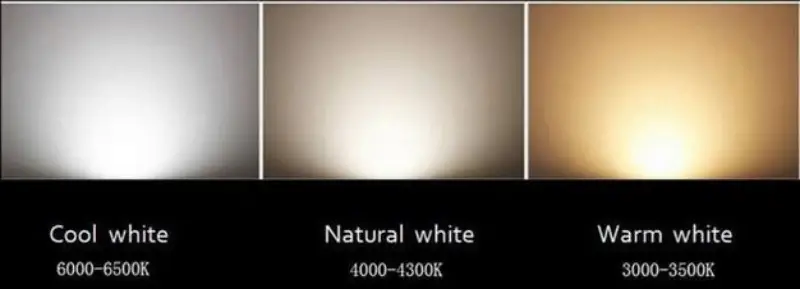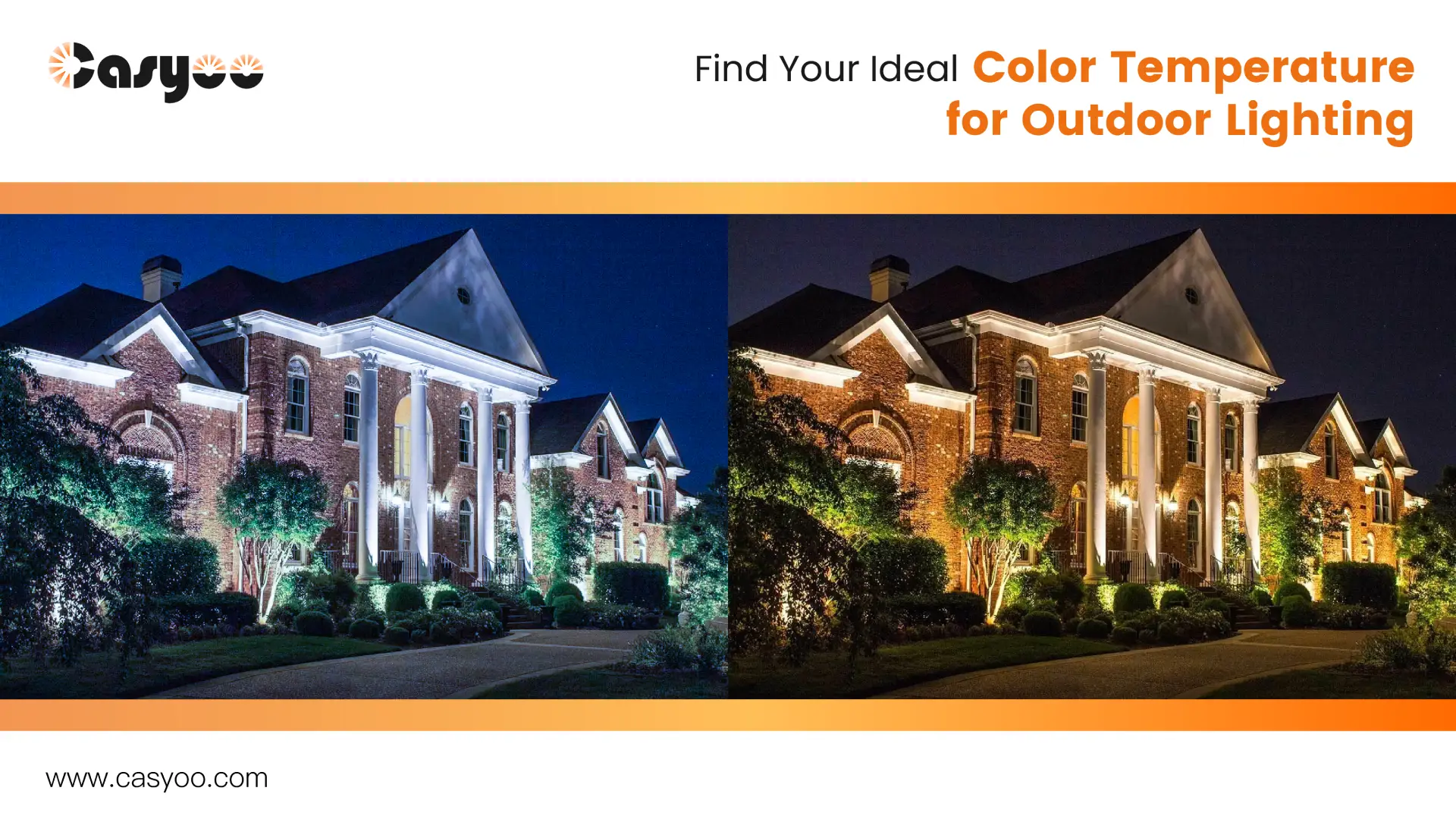Imagine stepping out into your backyard after the sun has set. The pathway shines subtly; your favorite tree throws a moon-cast shadow, and a seating area feels warm and inviting. The secret? Choosing the right color temperature for outdoor lighting.
Outdoor lighting is about more than just making an area brighter; it’s about creating an atmosphere, a sense of security, and showcasing your property’s qualities. Whether you are a homeowner, landscape designer, or property manager, mastering color temperature can significantly improve your outdoor lighting. This guide should make the process easier for you, so you can be confident in making the proper decisions for any outdoor application.
Understanding Color Temperature
What Is Color Temperature?
Color temperature, measured in Kelvin (K), describes whether a light is warm, neutral, or cool. Lower Kelvin values, such as 2700K, have a warm, yellow glow, whereas higher values, like 5000K, give off crisp, bluish-white light.
Imagine the yellow glow of a campfire on a clear day and the clarity of daylight. The differences are not just aesthetic; they evoke different sensations within a space. Warm tones relax us, while cool tones improve focus and visibility.
Why It Matters for Outdoor Lighting
- Ambiance: Warm light makes spaces feel cozy; cool light feels bright and contemporary.
- Functionality: Neutral tones highlightgreenery and
- Safety: Bright, cool tones increase visibility in high-traffic, high-risk areas such as walkways.
Comparing Warm White and Cool White
Characteristics and Best Uses
Warm White (2700K–3000K) — Soft, yellowish light. It creates a great atmosphere in recreation places like gardens and patios. The light accentuates earthy tones found in materials such as wood and brick that create an inviting space outdoors.
Cool White, on the other hand, retains its brightness with bluish light (5000K–6500K). Such illumination is perfect for security areas, parking lots, and modern designs in need of clear, sharp focus.
Visual Effects on Materials
The temperature of the light also has an impact on how surfaces and textures are rendered. Cool tones elucidate clean, contemporary surfaces like metal and glass, while warm tones accentuate the inherent beauty of stone and wood. This distinction might aid in defining your outdoor space’s general vibe.
Popular Color Temperatures: 3000K, 4000K, and 5000K
3000K: Natural and Inviting
3000K lights are the go-to choice for residential and recreation areas. They strike just the right balance between being warm and bright, making them perfect for gardens, driveways, and smaller walkways. This temperature enhances natural tones, giving minimal glare, and is usually very soothing and comfortable in nature.
4000K: Crisp and Balanced
This neutral white color is clear without being harsh, like cooler temperatures. It’s perfect for areas where good visibility and aesthetics are important—like stairs, entryways, and shared walkways.
5000K: Bright and Secure
At the upper end of the temperature spectrum, 5000K lighting reproduces daylight and is the brightest light level possible. It is best suited for garages, security zones, and high-exposure areas. Its boldness makes it less appealing in social environments, and therefore it should be sparsely used in residences.

3000K vs. 4000K vs. 5000K: Environmental Impact
Considering the environmental impact on wildlife and light pollution the 3000K bulb makes the least impact. Its lower blue light emissions make it a more sustainable choice for suburban or rural areas. At the other end of the scale, 5000K lighting, while supremely efficient at reducing the number of fixtures needed for large spaces, emits the most blue light. While use in large amounts might disrupt nocturnal habitats, appropriate placement and shielding can mitigate these effects.
Guidelines for Choosing Color Temperature by Application
Residential Outdoor Lighting
The temperature range between 2700K and 3000K gives the best result in creating a warm and inviting ambiance. These warm hues work very well with natural materials such as wood and stone, making patios, porches, and gardens feel very cozy and inviting. For a pathway or driveway, the slightly cooler temperature of 3000K to 4000K has better visibility and still looks great in harmony with your home’s exterior.
Imagine a garden path lit by 3000K lights that are soft and gentle, directing guests without overpowering the tranquil environment. That would subtly raise the whole ambiance of a residential place.
Landscape Lighting
Neutral tones in the 3000K to 4000K range are ideal for highlighting greenery and water features. These tones mimic natural daylight, enhancing the vibrant greens of plants and the reflective qualities of water. To emphasize architectural details or sculptures, consider 4000K, which offers a crisp contrast that draws attention without feeling harsh.
For example, uplighting a tall tree with 4000K fixtures mimics the effect of moonlight filtering through its leaves—a favorite technique among professional designers.
Security Lighting
Safety requires clarity; 4000K to 5000K lighting excels here. This bright, bluish lighting provides better visibility, deters would-be intruders, and improves the operation of outdoor cameras. Place these lights around garages, parking lots, or sequestered walkways to improve security.
However, because it could come across as overly clinical, avoid using this intensity in public spaces like patios. Rather, combine with warmer lighting to achieve a balance between comfort and usefulness.
Special Scenarios
- Moonlighting Effect: To simulate soft moonlight, use 4000K lights positioned high in trees or other objects. Natural highlights and shadows are produced, which is perfect for designs of calm gardens.
- Seasonal Adjustments: The use of warmer tones, such 2700K to 3000K, makes a space feel cozy throughout the winter months. In the summer, it feels lively and fresh with neutral colors like 4000K.
Benefits of Using LED Lighting
With advantages that go well beyond those of conventional lighting, LED lighting has completely transformed outdoor illumination. It’s the go-to option for both homeowners and pros for the following reasons:
- Energy Efficiency: Due to their significantly lower energy use, LEDs are both economical and environmentally beneficial.
- Longevity: With the ability to last up to 50,000 hours, LEDs cut down the need for frequent replacements and save time and money.
- Enhanced CRI: High Color Rendering Index ensures that outdoor features look vibrant and maintain their true colors.
- Durability: Built to endure the harshest weather conditions, LED lights perform well outdoors.
- Versatility: Available in a wide range of color temperatures, LEDs cater to all applications, from cozy patios to high-security zones.
Layered Lighting and Design Tips
Combine Warm and Cool Lights
Layering several color temperatures gives depth and purpose to your outdoor lighting design. Use warm white (2700K) to improve the mood in seating areas, and cold white (4000K) along walkways to increase safety and visibility.
5000K spotlights will also help to emphasize some specific features such as fountains or trees thus adding dramatic effects to the design. It is not just that the contrast between the warmth and cool tone creates aesthetic appeal. It also makes sure that every space functions as intended.
Practical Suggestions for Placement
- Use dimmable warm lights in social areas like patios to adjust the mood for different occasions.
- Install neutral white lights for functional areas like stairs or pathways to ensure safe passage.
- Without overwhelming the scene, narrow-beam spotlights draw emphasis to certain building details or unique landscaping aspects.
Illuminate Your Outdoors with the Perfect Glow
Color temperature is an underappreciated hero in outdoor lighting design. Whether you’re creating a warm nook for nighttime events, highlighting the natural beauty of your environment, or just assuring your property’s safety, the perfect Kelvin range affects how your place looks and feels.
For homeowners, 2700K to 3000K lights set the right mood for relaxation. Landscape designers will find great versatility in 3000K to 4000K when it comes to greenery and architecture. And property managers can depend on 4000K to 5000K for the security and functionality of shared spaces.
Transform your property after sunset with lighting as beautiful as it is functional. Contact Casyoo today to find your perfect outdoor lighting solution!




